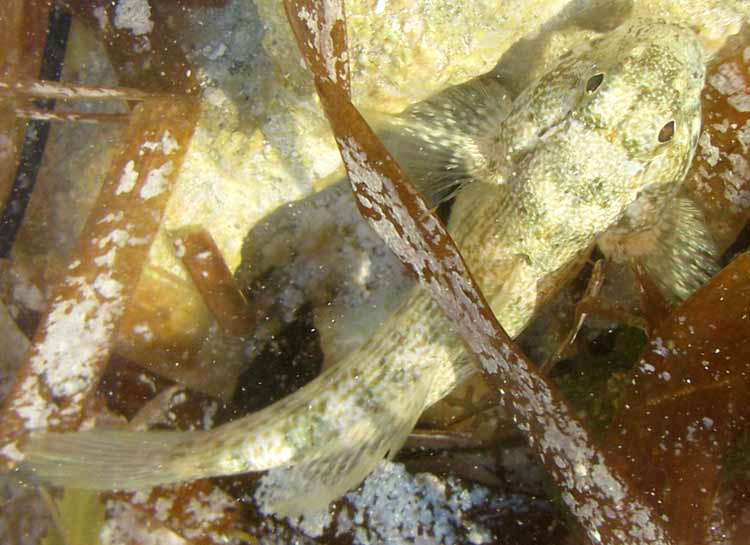Excerpts from Jim Conrad's
Naturalist Newsletter

from the June 12, 2011 Newsletter issued from Mayan Beach Garden Inn 20 kms north of Mahahual; Caribbean coastal beach and mangroves, ~N18.89°, ~W87.64°, Quintana Roo state, MÉXICO
A WELL ORIENTED GOBY
The tide was going out leaving shallow pools that only the biggest waves managed to slosh into. Inside one basketball-size pool a pale gray, flat-headed fish half a finger long looked up at me, as shown above.
With the tide going out, soon not even the largest waves would reach the pools, so I wondered whether the fish might get stranded. In such an exposed, small pool he'd be easy pickings for a fish-eating bird. However, I was too busy taking the above picture to think much about it. Unfortunately, in that picture a blade of Turtlegrass awkwardly slants across the field, so after snapping the photo I slowly dipped my finger into the water to nudge the blade out of the way.
But, before my finger got close, in a flash, the fish took advantage of the remains of a big wave briefly washing into the pool. Half swimming, half squirming, he shot out of the pool onto the lowest part of the surrounding rock face and in less than 1/5th of an inch of water flopped and wiggled across a yard of limestone before diving beneath some Turtlegrass in the surrounding shallows.
Clearly, he'd known exactly the best escape route -- where the rock rim surrounding his pool was lowest and where open water was on the other side -- despite being unable to see it from inside the pool. And he'd coordinated his escape perfectly with the arrival of the remains of a large wave.
However, there was more: As I was turning away from the pool a certain flipping and wiggling caught my eye, and when I looked back into the pool, there he was again, having bodysurfed another wave back into it. How could such a tiny brain be capable of such timing, positional orientation and audacity?
The fish was a Frillfin Goby, BATHYGOBIUS SOPORATOR, distributed from South Carolina south to Brazil, along tropical Africa's western coast, and in tropical southeast Asia and Oceania.
I'm not the first to be in awe of the tide-pool-escaping-and-entering behavior of the Frillfin Goby. A 1951 article in American Museum Novitates #1486, published by the American Museum of Natural History, notes that "these fish are so well oriented before jumping that they always land safely in a neighboring pool or in the open water. The conditions are such that the fish could not possibly see the neighboring pools before leaping."
Now that I know what to look for, whenever I approach several small, close-together tide pools I watch to see if someone leaps from one pool to another, and often I do see it! This is a spectacle I've been missing until now, something that even Marcia didn't know about.
Frillfin Gobies are practically omnivorous, with a special affinity for crustaceans.